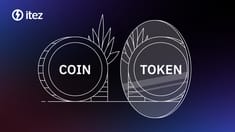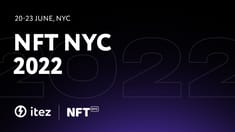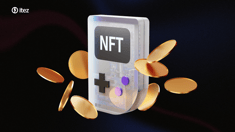There are about 23 thousand cryptocurrencies in the market. All coins differ in origin, operational principles, and usage methods. To avoid confusion, users categorise them into distinct groups. Let’s explore the different types of coins in the crypto market and their potential uses.
Introduction to cryptocurrency coins and tokens
Cryptocurrencies have revolutionised the financial landscape, offering decentralised and borderless alternatives to traditional currencies. At the core of this innovation lie coins and tokens, two distinct types of digital assets that play crucial roles within the cryptocurrency ecosystem.
What are cryptocurrency coins?
Cryptocurrency coins are the native currencies of blockchain networks. They are typically used as a medium of exchange, store of value, or unit of account within their respective coin networks. Coins operate on their own independent blockchains and are often mined or staked to validate transactions and secure the network.
There are three ways to use crypto:
- Payment tool. All cryptocurrencies are payment tools, which means they can be used to pay for goods and services. But before using it, it’s important to clarify the legality of the transaction in a certain country. In some states, the authorities have not clearly decided on the status of cryptocurrencies. For example, the US regulators are torn between two classes: securities and commodities. Both categories are far from cryptocurrencies as they are more suitable for settlements than securities and commodities, because they are much easier to buy, sell, or exchange. Learn more about the legalisation of cryptocurrencies.
- Investment tool. Not all coins are directly used for payments. For example, Bitcoin (BTC) nowadays is more suitable for being a saving tool due to its high fees and scarcity.
- Utility token. Utility tokens are digital assets that provide access to some services/goods/benefits. Many decentralised finance (DeFi) projects have tokens that give users an opportunity to participate in voting processes that determine the platform's future.
All transactions are conducted with the help of the blockchain technology, which provides transparency in a decentralised way.
What are cryptocurrency tokens?
Cryptocurrency tokens, on the other hand, are assets built on existing blockchain platforms. Unlike coins, tokens do not have their own native blockchain but rely on established blockchain networks such as Ethereum (ETH) or Binance Smart Chain (BSC) to function. Tokens are created through smart contracts and can represent various digital or physical assets, rights, or functionalities.
In short, “cryptocurrency”, “coin”, and “digital asset” mean almost the same. The main thing is not to call Bitcoin an «altcoin» (altcoin is a term used for all coins that came after BTC). You should also be careful with the word “token”, which is used to determine coins that run on other cryptocurrency's blockchain and provide access to additional features within the community.
There are several approaches to the cryptocurrencies classification. Most often, they are divided based on their technical features and usability. At the same time, all cryptocurrencies have two common features: the same ancestor in the face of Bitcoin and the ability to use them for settlements.
Coins: native currencies of blockchain networks
Cryptocurrency coins serve as the foundation of their respective blockchain networks, facilitating peer-to-peer transactions and powering decentralised applications (dApps). Let's delve into the features of coins and explore some popular examples.
Features of cryptocurrency coins
We can determine three main features:
- Independent blockchains. Coins operate on their own dedicated blockchains, which are decentralised ledgers that record all transactions.
- Mining or staking. Many coins utilise mining or staking mechanisms to validate transactions and secure the network. Coin mining process depends on the protocol. Proof-of-Work (PoW) is a classic, while Proof-of-Stake (PoS) is an eco-friendly one.
- Limited supply. Most coins have a predetermined maximum supply, ensuring scarcity and often contributing to their value appreciation over time.
Examples of popular coins
Bitcoin (BTC). The first and most well-known cryptocurrency, Bitcoin is often referred to as digital gold due to its scarcity and store of value properties.
Ethereum (ETH). Ethereum is not only a cryptocurrency but also a token platform for building dApps and smart contracts.
Litecoin (LTC). One of the oldest coins, which mirrors Bitcoin’s main principles. Litecoin is well-known in the crypto community as digital silver.
Tokens: assets built on blockchain platforms
Cryptocurrency tokens are versatile assets that leverage the infrastructure of existing blockchain platforms to offer a wide range of functionalities and use cases. Let's explore the unique features of tokens and examine some examples from various token categories.
Features of cryptocurrency tokens
We can determine three main features of cryptocurrency tokens the crypto community members should be aware about:
- Built on existing platforms. Tokens are created using smart contracts on established blockchain platforms, enabling developers to customise functionalities and attributes.
- Diverse use cases. Tokens can represent digital or physical assets, voting rights, access to services, or even ownership in real-world assets.
- Token standards. Standardised token protocols such as ERC-20 (Ethereum) or BEP-20 (Binance Smart Chain) provide interoperability and ease of integration with wallets and exchanges.
Utility tokens and security tokens
Utility tokens are tokens that provide access to a product or service offered by a project or platform. Examples include Binance Coin (BNB), which is used to pay for transaction fees on the Binance exchange.
Security tokens, in their turn, represent ownership in real-world assets (RWA) such as equity, debt, or revenue share. They are subject to regulatory scrutiny and must comply with securities laws.
Examples of popular tokens
Chainlink (LINK). A decentralised oracle network that connects smart contracts with real-world data.
Uniswap (UNI). The native token of the Uniswap decentralised exchange (DEX), which facilitates automated trading of cryptocurrencies.
Filecoin (FIL). Prominent decentralised physical infrastructure networks (DePIN) project that has revolutionised data storage approach.
Key differences between coins and tokens
While both coins and tokens are essential components of the cryptocurrency ecosystem, they differ significantly in their purpose, underlying infrastructure, creation, distribution, and regulatory considerations.
Purpose and functionality. Coins are primarily used as digital currencies for transactions and store of value. Tokens, in their turn, serve diverse functions beyond currency, including access to services, voting rights, and asset representation. In the combination “coin vs token" you should pick one depending on your needs.
Blockchain infrastructure. Coins operate on their own independent blockchains, with unique consensus mechanisms and network protocols. This makes them local native currency. Tokens are built on existing blockchain platforms, leveraging their infrastructure and smart contract capabilities.
Creation and distribution. Coins are typically distributed through mining or staking mechanisms, with predetermined issuance schedules. Tokens are created through smart contracts on blockchain platforms, often distributed through initial coin offerings (ICOs) or token generation events (TGEs).
Regulatory considerations. Coins are generally considered as currency substitutes, subject to regulations governing money transmission and taxation. Tokens vary regulatory treatment depending on their classification as utility tokens, security tokens, or other forms of digital assets. Crypto regulations differ from country to country. Every authority has its own approach, which is not always crypto-friendly.
Coins and tokens in the crypto ecosystem
Coins and tokens play integral roles in the dynamic and evolving cryptocurrency ecosystem, driving innovation, enabling DeFi applications, and facilitating crypto trading.
The role of coins and tokens in crypto trading
It is possible to determine three main roles coins and tokens play in the crypto ecosystem:
- Liquidity providers. Coins and tokens with high trading volumes contribute to the market liquidity, facilitating smooth trading experiences for users.
- Price discovery. Trading pairs between coins and tokens enable price discovery and market valuation based on supply and demand dynamics.
- Investment opportunities. Cryptocurrency trading allows investors to benefit from price fluctuations and market trends.
Storing coins and tokens in crypto wallets
Coins and tokens require compatible wallets for storage and management. Hardware wallets, software wallets, and custodial services offer different levels of security and convenience.
Users should adhere to security best practices, such as using hardware wallets, enabling two-factor authentication (2FA), and safeguarding private keys. Only then their crypto assets are safe from thefts or losses.
Learn more about available crypto wallets using our comprehensive guide.
Conclusion: navigating the world of crypto coins and tokens
Understanding the differences between coins and tokens is essential for navigating the complex landscape of cryptocurrencies and making informed decisions when investing or participating in blockchain projects. As the crypto ecosystem continues to evolve, coins and tokens will remain integral components, driving innovation and reshaping the future of finance. Stay informed and embrace the transformative potential of crypto assets.
🤔 What do you think about crypto assets differences?
Subscribe our socials to stay updated on the hottest stories about cryptocurrencies!
💌 Telegram, Twitter, Instagram, Facebook
Here are three other cool articles:
12 facts you need to know about the Bitcoin halving 2024
How high can Bitcoin climb with halving? Top price predictions review
What is a spot bitcoin ETF, and why does everyone talk about it
This article is not an investment recommendation. The financial transactions mentioned in the article are not a guide to action. Itez is not responsible for possible risks. The user should independently conduct an analysis on the basis of which it will be possible to draw conclusions and make decisions about making any operations with cryptocurrency.








